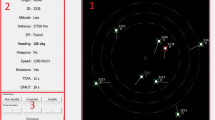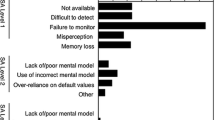Abstract
Task performance in uncertain and complex environments is dependent on human effectiveness in dynamic prioritisation and attention allocation. Non-routine critical events place a high demand on cognitive resources in operators, and they require operators to dynamically re-prioritise sub-tasks calling upon the need for predictive aids. Predictive aids provide real-time prediction of system variables, and they can potentially facilitate the detection of non-routine critical events and dynamic re-prioritisation during such events. However, prior research has reported mixed findings in their effectiveness, and no prior research has been done to test the effectiveness of predictive aids during non-routine critical events that require operators to dynamically prioritise tasks. Our experimental study with 77 participants examined the effect of a predictive aid on prioritisation of non-routine critical events in a cyber security event monitoring task. The predictive aid resulted in decrements in sustained attention as seen in delayed detection of some non-routine critical events and errors in prioritising non-routine critical events. This effect is a result of miscalibration in the importance of looking ahead with the predictive aid. This miscalibration was possibly associated with the look-ahead time, complexity of the predictive aid, and the lack of automation transparency (i.e. mechanism underlying prediction) together affecting its perceived usefulness. The experimental results have the following implications on the design and testing of predictive aids: (1) in a task requiring dynamic prioritisation and detection of non-routine critical events, predictive aids with insufficient look-ahead times can result in decrements in sustained attention; (2) predictive aids should be evaluated with subjective measures of perceived usefulness and workload; (3) predictive aids should be designed to have sufficient look-ahead times and transparency of underlying prediction mechanisms as these would affect visual scanning effort and perceived usefulness; and (4) experimental tests of their effectiveness should involve scenarios long enough that would take sustained attention effects and any potential learning effects into consideration.










Similar content being viewed by others
References
Andre AD, Heers S, Cashion P (1995) Effects of workload preview on task scheduling during simulated instrument flight. Int J Aviat Psychol 5(1):5–23
Chou CC, Madhavan D, Funk K (1996) Studies of cockpit task management errors. Int J Aviat Psychol 6(4):307–320
Colvin K, Funk K, Braune R (2005) Task prioritization factors: two part-task simulator studies. Int J Aviat Psychol 15(4):321–338
Craik FI, Lockhart RS (1972) Levels of processing: a framework for memory research. J Verbal Learn Verbal Behav 11(6):671–684
Cummings M, Mitchell P (2005) Managing multiple UAV’s through a timeline display. In: Proceedings of AIAA info tech, 2005
Cvach M (2012) Monitor alarm fatigue: an integrative review. Biomed Instrum Technol 46(4):268–277
D’Amico A, Whitley K, Tesone D, O’Brien B, Roth E (2005) Achieving cyber defense situational awareness: a cognitive task analysis of information assurance analysts. In: Proceedings of the human factors and ergonomics society annual meeting, vol 49, no 3, pp 229–233
Donald FM, Donald CH (2015) Task disengagement and implications for vigilance performance in CCTV surveillance. Cognit Technol Work 17(1):121–130
Endsley M, Garland D (2000) Situation awareness analysis and measurement. CRC Press, Taylor & Francis Group
Funk K (1991) Cockpit task management: preliminary definitions, normative theory, error taxonomy, and design recommendations. Int J Aviat Psychol 1(4):271–285
Ghazizadeh M, Lee JD, Boyle LN (2012) Extending the technology acceptance model to assess automation. Cognit Technol Work 14(1):39–49
Giacobe NA, McNeese MD, Mancuso VF, Minotra D (2013) Capturing human cognition in cyber-security simulations with NETS. In: IEEE Int Conf Intell Secur Inform (ISI), pp 284–288
Grier RA, Warm JS, Dember WN, Matthews G, Galinsky TL, Szalma JL, Parasuraman R (2003) The vigilance decrement reflects limitations in effortful attention, not mindlessness. Hum Factors J Hum Factors Ergon Soc 45(3):349–359
Hamilton K, Mancuso B, Minotra D, Hoult R, Mohammed S et al (2010) Using the NeoCITIES 3.1 simulation to study and measure team cognition. In: Proceedings of the human factors and ergonomics society annual meeting, vol 54, no 4, pp 433–437
Hart S, Staveland L (1988) Development of NASA-TLX (task load index): results of empirical and theoretical research. In: Hancock P, Meshkati N (eds) Human mental workload, vol 52. North-Holland, Amsterdam, pp 139–183
Hellar B, McNeese MD (2010) NeoCITIES: a simulated command and control task environment for experimental research. In: Proceedings of the human factors and ergonomics society annual meeting, vol 54, no 13, pp 1027–1031
Helton WS, Russell PN (2011) Working memory load and the vigilance decrement. Exp Brain Res 212(3):429–437
Hoffman R, Johnson M, Bradshaw M, Underbrink A (2013) Trust in automation. IEEE Intell Syst 28(1):84–88
Iani C, Wickens CD (2007) Factors affecting task management in aviation. Hum Factors J Hum Factors Ergon Soc 49(1):16–24
Lau N, Jamieson GA, Skraaning G (2013) Distinguishing three accounts of situation awareness based on their domains of origin. In: Proceedings of the human factors and ergonomics society annual meeting, vol 57, no 1, pp 220–224
Lee JD, McGehee DV, Brown TL, Reyes ML (2002) Collision warning timing, driver distraction, and driver response to imminent rear-end collisions in a high-fidelity driving simulator. Hum Factors J Hum Factors Ergon Soc 44(2):314–334
Mancuso V, Minotra D, Giacobe N, McNeese MD, Tyworth M (2012) idsNETS: an experimental platform to study situation awareness for intrusion detection analysts. In: Proceedings of the IEEE CogSIMA conference, New Orleans, pp 73–79
Metzger U, Parasuraman R (2005) Automation in future air traffic management: effects of decision aid reliability on controller performance and mental workload. Hum Factors J Hum Factors Ergon Soc 47(1):35
Minotra D (2012) The effect of a workload-preview on task-prioritization and task-performance. Dissertation, The Pennsylvania State University, University Park
Morris C, Leung Y (2006) Pilot mental workload: How well do pilots really perform? Ergonomics 49(15):1581–1596
Nunes A (2003) The impact of automation use on the mental model: findings from the air traffic control domain. In: Proceedings of the human factors and ergonomics society annual meeting, vol 47, no 1, pp 66–70
Nunes A, St-Cyr O (2003) Predictive aids and mental models under free flight: proceed with caution. In: Proceedings of the 12th international symposium of aviation psychology, Dayton
Parasuraman R (2005) Workload modeling and workload management: recent theoretical developments. Department of Psychology, George Mason University, Fairfax
Prinet JC, Terhune A, Sarter NB (2012) Supporting dynamic re-planning in multiple UAV control: a comparison of 3 levels of automation. In: Proceedings of the human factors and ergonomics society annual meeting, vol 56, no 1, pp 423–427
Raby M, Wickens CD (1994) Strategic workload management and decision biases in aviation. Int J Aviat Psychol 4(3):211–240
Roberts R, Flin R, Cleland J (2014) Staying in the zone offshore drillers’ situation awareness. Hum Factors J Hum Factors Ergon Soc. doi:10.1177/0018720814562643
Rummel J, Meiser T (2013) The role of metacognition in prospective memory: anticipated task demands influence attention allocation strategies. Conscious Cognit 22(3):931–943
Smilek D, Eastwood D, Reynolds M, Kingstone A (2007) Metacognitive errors in change detection: missing the gap between lab and life. Conscious Cognit 16(1):52–57
Solet JM, Barach PR (2012) Managing alarm fatigue in cardiac care. Progress Pediatr Cardiol 33(1):85–90
Szafir D, Mutlu B (2012) Pay attention!: designing adaptive agents that monitor and improve user engagement. In: Proceedings of the SIGCHI conference on human factors in computing systems, pp 11–20
Vicente KJ (1999) Cognitive work analysis: toward safe, productive, and healthy computer-based work. CRC Press, Taylor & Francis Group
Wellens R, Ergener D (1988) The CITIES game. Simul Gaming 19(3):304–327
Wickens CD (2001) Attention to safety and the psychology of surprise. In: Proceedings of the 2001 symposium on aviation psychology
Wickens CD (2015) Situation awareness its applications value and its fuzzy dichotomies. J Cognit Eng Decis Mak 9(1):90–94
Wickens CD, Pizzaro D, Bell B (1991) Overconfidence, preview, and probability in strategic planning. In: Proceedings of the 35th human factors and ergonomics society meeting, vol 35, no 20, pp 1556–1560
Wickens CD, Heather D, Merlot J (1999) Integration of information sources of varying weights: the effect of display features and attention cueing. Savoy Aviation Research Lab, University of Illinois, Urbana-Champaign
Yeh M, Wickens CD, Seagull F (1999) Target cuing in visual search: the effects of conformality and display location on the allocation of visual attention. Hum Factors J Hum Factors Ergon Soc 41(4):524–542
Zhang G, Feyen RG (2005) A conceptual framework for dynamic prioritization in multiple-task scenarios. In: Proceedings of the human factors and ergonomics society annual meeting, vol 49, no 12, pp 1172–1175
Zhang G, Feyen RG (2007a) Hierarchical task prioritization behavior in two-and four-task scenarios. In: Proceedings of the human factors and ergonomics society annual meeting, vol 51, no 4, pp 191–195
Zhang G, Feyen RG (2007b) A queueing network model of task prioritization using a general hierarchy of prioritization rules. In: Proceedings of the human factors and ergonomics society annual meeting, vol 51, no 12, pp 807–811
Acknowledgements
This work was partially supported by US Army Research Office (ARO) MURI Grant ‘Computer Aided Human Centric Cyber Situation Awareness’ W911-NF-09-1-0525. We would like to thank members of the MINDS Lab at Penn State for their support. We would like to thank the reviewers for their insightful comments. Additionally, the support and input from Dr. Catherine Burns, Dr. Xiaolong Zhang, and Dr. Ling Rothrock are also highly appreciated.
Author information
Authors and Affiliations
Corresponding author
Rights and permissions
About this article
Cite this article
Minotra, D., McNeese, M.D. Predictive aids can lead to sustained attention decrements in the detection of non-routine critical events in event monitoring. Cogn Tech Work 19, 161–177 (2017). https://doi.org/10.1007/s10111-017-0402-x
Received:
Accepted:
Published:
Issue Date:
DOI: https://doi.org/10.1007/s10111-017-0402-x




